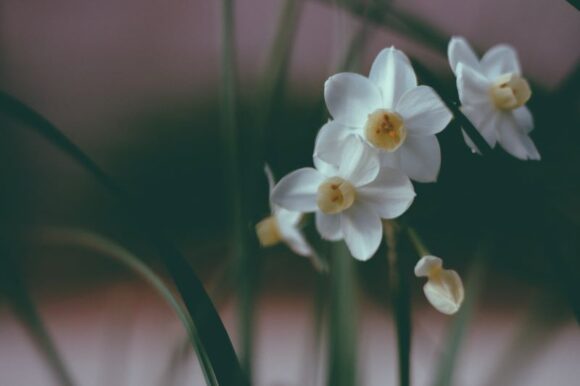

This winter, as in other winters, when I need a blossom boost, I have enjoyed the fragrance of paper-white narcissus that I planted in tall glass vases. I surrounded the bulbs with seashells from White Sands Beach here in Old Lyme and kept them in a dark cool area keeping them moist as the roots developed. When the bulb foliage reached about six inches, I introduced the bulbs to indirect light.
The fragrance of this plant is so refreshing and each morning when entering my lounge, I inhaled it and felt immediately uplifted and ready for my day. I keep extra bulbs in a brown paper bag in the vegetable keeper in the refrigerator. These bulbs, I plant when the first blooms have gone by. With this method, I have a succession of bloom and fragrance in my home into spring.
In his annual appearance this year, the Groundhog let us know that we have six more weeks of winter. On that note, it’s a recognition for all gardeners that there is much to decide on and plan for this season in our gardens. The warm breath of Spring will be here before you know it and we will be filled with the anticipation that lives within all gardeners to get outdoors and plunge our hands into the soil.
For all of us gardeners, there is so much to look forward to and, to reiterate my modus operandi, I continue to stress the importance for you to garden organically. In this country and around the world, the results of pollution and chemicals are just some of the factors that are causing climate change.
We are in a crisis, with invaders that have already battered down the gates and invaded our gardens. These invaders are destroying Mother Nature and your health in the form of poisonous pesticides and herbicides. The main producers of these poisons are Monsanto, Bayer and other biological monsters, who have been decimating our planet, our soil, human health and doing all those monstrous crimes purely for selfish profit.
We have all been able to observe the result of the global warming in the colossal melting of the glaciers and how that has affected polar bear population, causing their demise in great numbers through starvation and disease. Here in the United States, we have seen the terrible floods and tornadoes and recently in California, the catastrophic flooding and mudslides.
Bees have been killed in the millions when our EPA under the Trump administration allowed the spraying of over 14 million acres of land, with poisonous chemicals. Bees pollinate 70 percent of the world’s food and their demise is our demise.
Last year was recorded as the hottest year on record. In this country, the drought in the west, that resulted in dry tinder conditions, caused devastating fires that brought death and destruction to many in California, Oregon and Colorado. Extreme weather patterns evident in the blizzards throughout this country and the deadly hurricanes are due to the rise of our oceans and the result of warming water. Climate has also had a tragic effect on earthquakes as we see in Turkey and Northern Syria.

Please do not listen to the naysayers who deny climate change, tell them to open their eyes to witness the results.
As gardeners, it is our task to help counteract these negative changes by using only organic methods of gardening on your own plot of land; what we do is in our own small patch of earth all contributes to healing the planet.
Over the span of over 20 years on my radio show WRCH 100.5 FM and through my Garden Earth lectures, I have received a commitment from thousands of people to discard all poisonous herbicides and pesticides and to garden organically. The response had been tremendously positive in the production of healthy gardens grown in healthy soil.
It begins by what you put into the soil for the growth of the plants, accomplished by adding liberal doses of my favorite stuff – manure. Manure either from the farm or in bags from the garden center. The following insert is from a book I am writing on gardening and the humus component.
In 1937, Franklin D Roosevelt said that ‘the nation that destroys its soil destroys itself.’
America has not heeded that warning. Precious soils in this country and around the world are being destroyed by dangerous practices in industrialized agriculture and poisonous chemicals, which completely disrupt our ecosystem and poison all living things.
In your own garden, you can build and retain a rich growing environment by building the Humus component. We are all carbon-based creatures as is all life on earth. Not only humans but also our soil microbes need carbon to flourish. And to attract carbon from the atmosphere into your soil you need to build the humus component.
How to Build the Humus Content
Do not till soil – tilling breaks up soil structure.
Step #1
Add composted manure three times each season –beginning in spring when the soil has reached a temperature of 50 degrees. If the soil has not reached that temperature, the soil organisms are not able to work with the bacteria in the manure to produce nutrients for the roots of the plants. Purchase a soil thermometer to check the soil’s temperature.
This year, following deep frosts the soil temperature may reach 50 degrees by the end of April to early May. Add the manure again in July to continue to nourish your growing plants and again in October to protect and nourish your plants through the winter. Manure is not a fertilizer; it builds soil structure and works with all the soil animals to keep a healthy disease-free growing environment.
Step #2
Add wood chips in the form of brown fine bark mulch or wood chips that you produce from your garden of aged wood chips with a combo of leaves, twigs and branches.
These two major steps build the humus component. If you do this in your garden – not only will you helping to heal the planet but also produce the healthiest of gardens.
A question I am often asked is, ‘Can I put manure over mulch for example in my July garden’? The answer is ‘yes’ – the manure together with nature’s moisture and your own irrigation enables the manure to find its way easily into the soil and the roots of your plants.
What Exactly Does Humus Do?
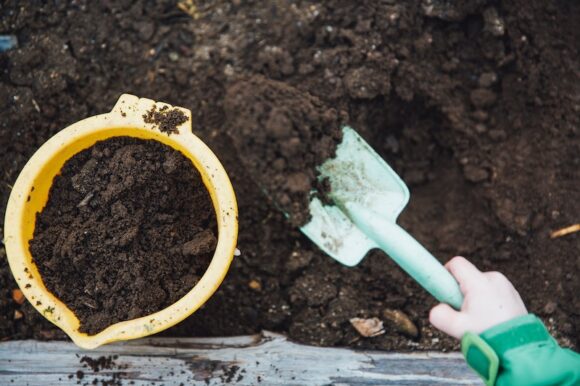
Humus acts like a sponge and can hold 90 percent of its weight in water.
Because of its negative charge – plant nutrients stick to humus for nitrogen, calcium, phosphorus and other elements, which prevents these from washing away and acts as nature’s slow release fertilizer throughout the year.
Humus improves soil structure making it loose and friable, which helps a plant root in the soil with better access to nutrients, water and oxygen.
Humus also helps’ filter’ toxic chemicals from the soil, much like carbon-based water filtration systems that filter toxins from your water.
We cannot control industrialized agricultural practices, however, in your own garden you can make a difference. Feed the soil and it will feed the plants.
I have made statements about the humus component in tips, but I cannot over-stress its importance.
Now on to the next topic, this week I spoke with my friend Ann, who lives in Cheshire, in England, which is next door to my home county of Shropshire. Ann is an avid gardener and she told me that her daffodils are well above the soil and last week she started seeds in the greenhouse.
Seed-Planting in Connecticut
February 20th to March 20th is the time for serious indoor seed planting here. Check which garden centers are stocking organic seeds or go online for the organic varieties – one company that I use is “Botanical Interests”. Do not go overboard when buying packs of seeds as there are about 500 seeds in each packet. If you do purchase too many – have a seed sharing party with gardening friends.
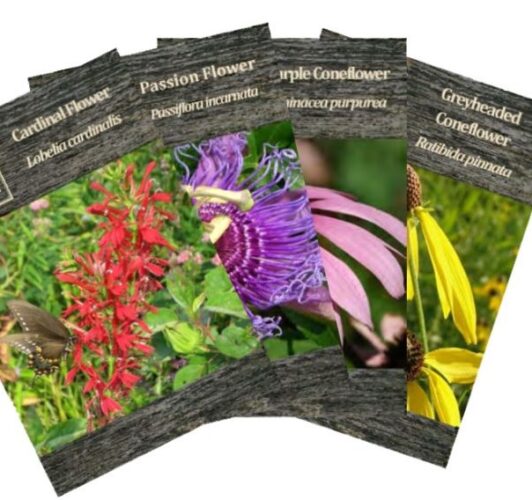
Equipment to have on hand for seed planting– cheap envelopes, fresh sterilized potting soil mix, and sphagnum moss. Also seed trays, egg cartons and cardboard milk containers that are cut down also work well. Make sure all containers are scrupulously clean. Sphagnum moss works well as a planting medium; the moss can prevent a soil born fungus that causes “damping off” which causes seeds to rot before germination. I have, together with many gardening friends used this method for years and have lost no seeds to “damping off”.
For tiny seeds, I use the moss as the planting mix and for larger seeds, I install a topsoil base and a layer of the moss on top of the soil. I mix fine seeds with sand before I sow; this method helps to loosen them up. Soak the seeds overnight before planting and just before planting spray them with warm water, never cold as cold water can delay germination. When they have germinated, water gently.
The best method of watering seedlings is to water from the bottom. But, if you feel you must top water, just mist with a fine sprayer, otherwise you will drown the delicate seeds, washing them out of the planting mix. Use new sterilized soil when seeding and do not save any leftover soil, add leftover soil mix to houseplants or put it in the garden. Leftover soil from the previous year, can develop disease, which can ruin future seedling crops. If you are growing seedlings on a windowsill, place them on a south or west-facing sill; seedlings need light, not heat to thrive.
Winter Care of Houseplants
My houseplants lift my spirits, especially in winter when the landscape is rather monochromatic. I talk to my plants enjoying the blooming variety and the different foliage varieties and thank them for cleaning the air in a stuffy home environment.
Keep your houseplants away from draughts and direct heat. If you are able, have humidifiers and air purifiers in the rooms, which will benefit not only the plants but also your own health. Place pebble trays under the plants and keep the pebbles moist for additional humidity.
Spray houseplants every few days with lukewarm water and once every couple of weeks, put the plants in a sink or bathtub and allow water to run freely over the plant to remove dust from the leaves and clean salt residue from the soil. The exception to the spray or soak rule is African violets as they do not do well with wet leaves.
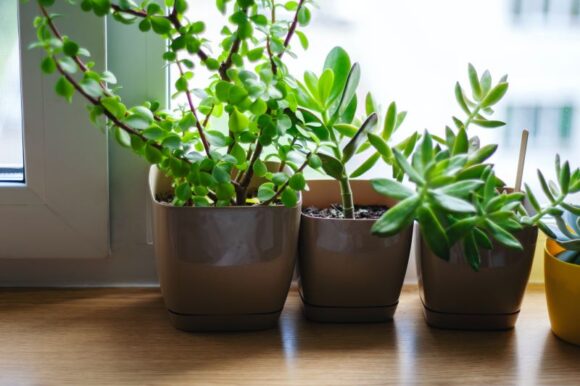
Aphids and white fly thrive indoors in winter and an organic sulphur solution called Safer works well to clean the soil of the insect eggs and from the foliage. Perhaps you are fortunate like me to have ladybugs in your home in winter; if so, allow these useful creatures to roam freely; the ladybug menu is aphids and white flies.
The best time to repot houseplants is from April through June but if a plant has become root-bound with no visible soil, then you can repot them in February. Water the plant to loosen the roots from the soil, turn it sideways on a newspaper and gently slide it from the pot.
Cut away any dead roots and repot in fresh potting soil in a clean pot that is only two inches larger than the original. With the plant firmly in place and the soil one inch from the rim, water it gently and do not fertilize with an organic fertilizer until April. Plants need this dormant period to recharge.
A few suggestions for trouble-free foliage plants in the home are Rubber plants, Spider plants, Ivy, Philodendron, Monstera and Spaphyllum. If you have a sunny window Aloes, Succulents and Cacti do great and offer trouble free variety.
Blooming plants sitting side by side with foliage plants, enjoying one another’s company, give one an impression of a miniature garden.
A few suggestions of bloomers are Cyclamen, African Violets, Kalanchoe, Primulas and Paper white narcissus. To prevent pets from chewing on the plants, add some cayenne pepper to the water when watering. I enjoy using my herbal plants, which sit in a sunny window. My favorites are Rosemary, Basil and Parsley, which are great additions to any recipe.
Power Tools
Gheck any power tools that require maintenance or repair. February or March is the time to get them into the repair shop, because as soon as the weather breaks the shops get busy and you may not get your lawn mower back until August.
Check all tools and implements in the garage or shed. If you did not clean them off at the end of last season, plunge the shovels and spades into a bucket of sand; sand is an abrasive and will clean off any leftover soil and manure residue. Oil the wooden handles of tools with Linseed oil or some inexpensive vegetable oil; oil feeds the wood and keeps the handles splinter free. At the same time, check your hoses and fittings that may have sprung leaks since last year.
Make a shopping list of new tools that are needed – there are lots of sales in late winter for you to get a good deal. However, I suggest that you buy only quality tools and hoses; as the saying goes, “you get what you pay for.” Also check that there are sufficient twine, bamboo rods, and wire ties or nails, bags of manure and peat on hand.
Making a Shopping List & Other Reminders
In March or early April when soil and manure are available purchase bags of composted manure from the garden center. On the other hand, if you have a farm close by sells aged manure, acquire a small truck to acquire a load. If you decide on that method, ask the farmer for manure from the bottom of the pile – aged stuff. Manure needs to be at least six months old before applied to your soil, as fresh manure will burn your plants.
Check the paintwork on your wooden fences, arbors, decks and any other outdoor wooden structures. Then, purchase paint supplies so that on a dry day in March for painting, everything will be on hand.
Don’t forget to put paintbrushes on your list – I have a feeling you forgot to clean your old brushes last season, which means they are ‘stiff as a poker’, also remember sandpaper, brush cleaner and if possible, buy eco conscious paint. If you are painting benches and garden seats on a dry day, put them under cover before sundown.
White walls in the greenhouse reflect light so any areas that need retouching, use white paint. It’s so rewarding to see how much lighter and brighter the greenhouse is after a touch of paint and the glass is cleaned. However meticulously clean and tidy your greenhouse, you may find that white fly, greenfly and scale insects have found their way inside the greenhouse for warmth and so it may be necessary to spray with an organic spray. I mix an organic spray of orange peels in white vinegar and allow it to sit for two weeks before spraying – this works well and is very economical.
Walking around a garden that looks good and feels good in mid-winter is a real pick-me-up. Patterns emerge created by paths, walls and hedges. As you walk, enjoy the shapes of shrubs, the shadows of evergreens and the strong silhouettes of tree trunks and enjoy their shape and bark without foliage.
Keep the bird feeders full. I love to watch the birds in their quick flights across the garden to alight on the feeders, and their sudden bursts of song when the sun peaks through. It is so much fun to watch the “pecking” order and see the blue jays, who can be bullies and red cardinals, who like the blue jays can be rather territorial. Bringing up the rear, come the finches and house sparrows. And sometimes a bird appears arrives that I do not recognize and out comes my binoculars and Peterson bird book.
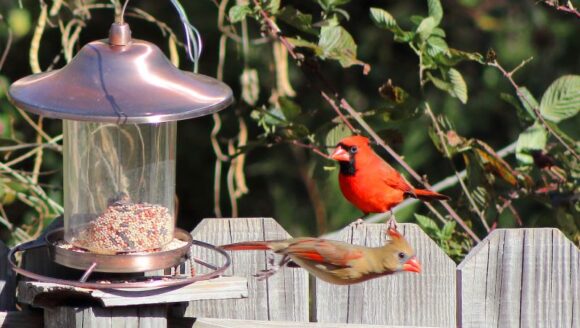
If you notice squirrels swarming the bird feeders, add some cayenne pepper to the birdseed; if that occurs, do not be concerned as the heat from the cayenne does not affect birds. Choose a spot away from the feeders to sprinkle cayenne-free birdseed on the ground so the squirrels can also enjoy a meal.
Winter has its own distinctive fragrance, the fog, in the morning when the air is very heavy, thick and damp – a damp that is even more bone-chilling than rain. I can deal with that for a while and know in about six weeks I will be inhaling the healthy, nose-clearing fragrance of the soil, rich and brown, well-manured or covered with wood mulch, shredded leaves or salt hay. Winter fragrances are a potpourri, one moment sharp and cold like the north wind, and spring’s flavors are light and sweet.
If you find you have spent year after year throwing good money after bad, it may be time to get a professional design, if that is so, don’t hesitate; if you want work to begin in the spring, a design takes time to complete. You may want to contact my son Ian, whose company LandscapesbyIan.com shows his creations and Ian will work with you and your budget.
Have a great month and I’ll see you in your garden in March. If you have any gardening questions, feel free to email me at MaureenHaseleyJones@gmail.com
About the author: Maureen Haseley-Jones is a member of a family of renowned horticultural artisans, whose landscaping heritage dates back to the 17th century. She is one of the founders, together with her son Ian, of, The English Lady Landscape and Home Company. Maureen and Ian are landscape designers and garden experts, who believe that everyone deserves to live in an eco-conscious environment and enjoy the pleasure that it brings. Maureen learned her design skills from both her mother and grandmother, and honed her horticultural and construction skills while working in the family nursery and landscape business in the U.K. Her formal horticultural training was undertaken at the Royal Botanic Gardens at Kew in Surrey.
If you have any gardening questions, feel free to email Maureen at MaureenHaseleyJones@gmail.com.